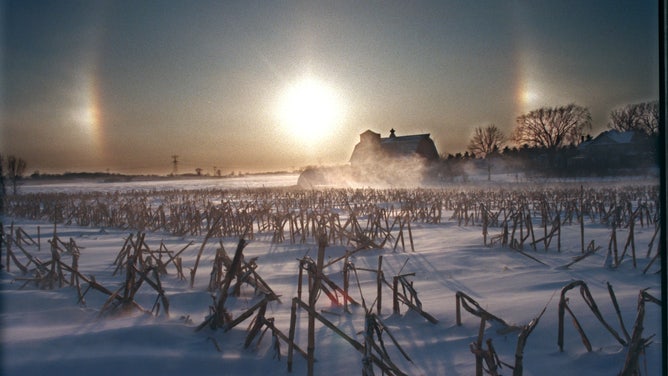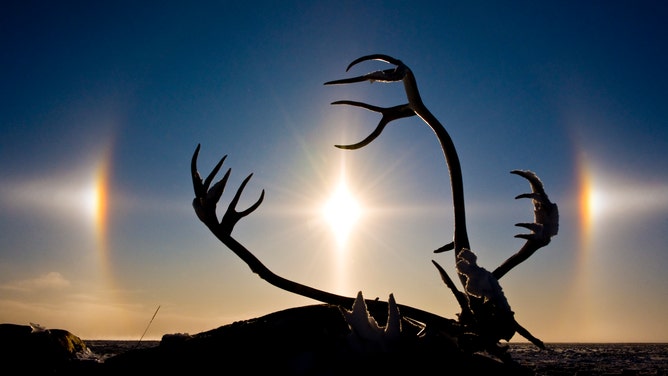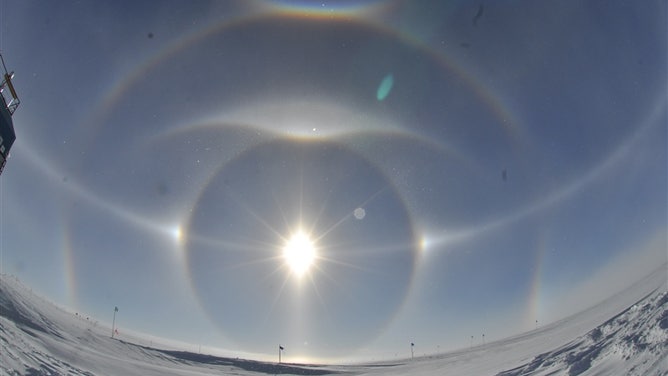What is a Sun Dog?
When high clouds are around, their ice crystals can bring two tiny rainbow "suns" on either side of the main sun.

Sundogs bracketed the setting sun as the wind whipped up snow on this frozen corn field near Bailey Rd. and Tower Dr. in the Woodbury area.
(David Brewster / Star Tribune / Getty Images)
It's a mostly sunny day out there, but as the sun glides behind some thin, wispy clouds, all of a sudden, the sun has company. Soon, a second ball of light begins to shine on one side of the sun, and maybe soon after, another bright spot forms on the opposite side. In the most brilliant displays, it's as if there are now three suns in the sky -- the main sun and two little siblings.
These "side suns" are colloquially known as sun dogs, officially known as "parhelia," which is Greek for "next to the sun."
And just like other rainbow-type displays in the sky, sun dogs result from light refracting off precipitation -- in this case, it's like tiny frozen…dinner plates?
"Sun dogs are formed when you have more orderly ice crystals," says Michael Kavulich, a research scientist with the National Center for Atmospheric Research.

Caribou (Rangifer tarandus) antlers at sunrise on snowy Hudson Bay coast, Churchill, MB, Canada.
(Dennis Fast / VWPics/Universal Images Group / Getty Images)
In this case, we have what is known as plate crystals that are six-sided shapes with flat tops but have some thickness to them.
"So it's kind of like a dinner plate, and those actually tend to fall slowly-- almost kind of fall straight down like a leaf," he said.
HOW ICE CRYSTALS CAN TURN ORDINARY CLOUDS INTO A BRILLIANT DISPLAY OF RAINBOW COLORS
Sunlight hitting the top and bottom of the flat parts of the crystals will reflect sunlight like a mirror. But sunlight that goes in the thick sides of crystals will refract into rainbow colors, similar to a prism.
"And since that angle (of refraction) is 22 degrees, you see two bright spots on either side of the sun," he said. Though sometimes it may only be on one side, depending on where the high clouds are in reference to the sun.
Since sun dogs rely on air cold enough to hold ice crystals instead of water droplets, the display usually requires clouds hanging out quite high in the atmosphere where it's below freezing. But in colder places where freezing air is down to the surface, displays can be pretty impressive.
WHY IS THERE A HALO AROUND THE SUN?
"Some pictures you see of the most spectacular sun dogs and atmospheric optics displays come from arctic places in the South Pole and things like that, where they have amazingly cold temperatures and these really crystal-clear ice crystals that just sort of hang in the air," Kavulich said.

Sun halos as spotted at South Pole Station, Antarctica in January 2012.
(Lieutenant Heather Moe / NOAA Corps)
But even warmer climates can still see these arcs.
"Even on the hottest summer day, if it gets to 100 degrees, you can still go high enough in the atmosphere that it's going to be below freezing," Kavulich says. "And you can get these ice crystals with the right conditions, even the South, in places like Florida and Texas, where you think it's hot all the time."